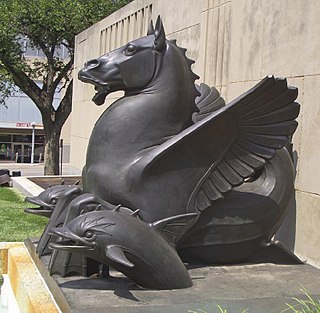A seahorse is a marine fish belonging to the genus Hippocampus.
Contents
Seahorse or seahorses may also refer to:
A seahorse is a marine fish belonging to the genus Hippocampus.
Seahorse or seahorses may also refer to:
James may refer to:

A seahorse is any of 46 species of small marine bony fish in the genus Hippocampus. "Hippocampus" comes from the Ancient Greek hippókampos (ἱππόκαμπος), itself from híppos (ἵππος) meaning "horse" and kámpos (κάμπος) meaning "sea monster" or "sea animal". Having a head and neck suggestive of a horse, seahorses also feature segmented bony armour, an upright posture and a curled prehensile tail. Along with the pipefishes and seadragons they form the family Syngnathidae.
Messenger, Messengers, The Messenger or The Messengers may refer to:

Pierre-Esprit Radisson (1636/1640–1710) was a French coureur des bois and explorer in New France. He is often linked to his brother-in-law Médard des Groseilliers. The decision of Radisson and Groseilliers to enter the English service led to the formation of the Hudson's Bay Company. His career was particularly notable for its repeated transitions between serving Britain and France.

The hippocampus or hippocamp, also hippokampos, often called a sea-horse in English, is a mythological creature shared by Phoenician, Etruscan, Pictish, Roman and Greek mythology, though its name has a Greek origin. The hippocampus has typically been depicted as having the upper body of a horse with the lower body of a fish.
Several vessels have been named Carnatic, for the Carnatic region of India.
A walrus is a large, flippered marine mammal.
A pelican is a bird of the family Pelecanidae.
Manitoba is a province of Canada.
Lively may refer to:
A dryad is a form of mythological Greek nymph associated with trees.
The stork is a long-legged wading bird.
Lily, Lilium, is a genus of flowering plants with large flowers.
Prince Rupert refers to Prince Rupert of the Rhine (1619–1682), noted German and British soldier, admiral, scientist, sportsman, colonial governor, and amateur artist.

A water horse is a mythical creature, such as the Ceffyl Dŵr, Capaill Uisce, the bäckahäst and kelpie.
Several vessels have been named Ruby:
King George was launched on the Thames in 1781. She spent about three-quarters of her career sailing for the Hudson's Bay Company (HBC), and was the third vessel by her name to sail for the HBC. She then spent the last quarter of her career as a whaler in the British northern whale fishery. She foundered there without a trace in 1822.
Sea Horse was launched in 1782 at Gravesend for the Hudson's Bay Company. She then became a merchantman that a French naval squadron captured in 1795. She next became the Spanish merchantman Principe Fernando, which a Guernsey privateer recaptured in January 1800. She became a merchantman again, and then made one voyage as a whaler. She became a Government transport and it was as a transport that she was wrecked in 1816 with great loss of life.